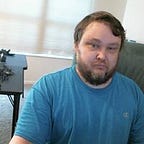Control Review: The Bluest Eye
I, Dalton Lewis, read a book: The Bluest Eye by Toni Morrison. It’s a young adult novel, mostly, a story about a bunch of black girls trying to live their lives in the mid twentieth century — black girls who consider themselves ugly. Pecola wishes that she was blonde-haired and blue-eyed. She lives in an abandoned storefront with her mom and dad. Mom and Dad fight — and when they fight, they attack each other physically, him drunk with fists, her with frying pans and whatever prop she can find near her.
Other young people are there, too. They hate the pretty, connected black girls who sell out to the white people. Much is made of the family that does what the white people want and sell out. They are nice and kind and gentle and don’t make waves and treasure their place below the white people. They despise the black people who fight back — who don’t accept their place at the bottom of society — the people who fight.
The father — Cholly — was dropped at a railroad track when he was a few days old and rescued by an aunt who raised him. Much is made of this. He then grew up to be a drunk, abusive asshole named Cholly. Toni Morrison wrote about the experience of being a young black girl who was abused — but she tried to humanize and explain the perspective of the monstrously evil rapists who mistreat said girls in stories. Cholly is watched by two racist white men the first time he has sex. He also looks for his father who wants nothing to do with him. He is turned into a drunken rapist by society and his decisions, not merely a cartoonish desire to be evil.
Soaphead Church is another abusive man, who wants to abuse girls and is apparently homosexual but hates himself for it. He abuses girls until the girls and their parents figure out about it and stop sending girls to hang out with him.
Pauline — Polly — is Pecola’s mother. She works for a rich white family who live in a nice white home. They are seen as a nice, nuclear family who look down on the poor black people. The racism is apparent in this story. The narrator cuts up the white dolls towards the beginning of the story — symbolic of something — I don’t know what.
The story starts each chapter with Dick and Jane references that show what a conventional, happy family should be and then contrasts that with the chaos and disharmony of the family of her story. This is a marvelous contrast that Morrison does. This entire book shows racism and self-hate — the idea that blue eyes are a symbol of beauty and that Pecola considers herself ugly. That is the sin of the novel, and the rape takes away her childhood.
Rape happens in real life all the time so it should be addressed in story as well, and this is one of the stories which gets it right. It isn’t sexy or glamorous or based on anything but pain and anguish and desperation. It doesn’t turn it into something sexual but instead shows it as an act of violence and sadness. The girls — Pecola’s friends — respond by hoping for the best for Pecola and her baby. They want her to have a wonderful baby and wonderful life.
Toni Morrison obviously won the Nobel Prize for literature a long time ago and died a few years ago. She deserves it; this wasn’t a pity pick. Her novels are intelligent meditations on what it means to be a woman and a black woman. This book also meant something to me because I love stories about being a young person and growing up. This was an intelligent story about growing up young and ugly. Someone else grew up young and ugly and unhappy — me.
I was young and ugly and unhappy for many years. I can sympathize with Pecola on that count. I think that a lot of people can understand that feeling ugly is an almost-universal feeling, and I’m glad she wrote about it with such ferocity.
Thanks, and take care, friends.
